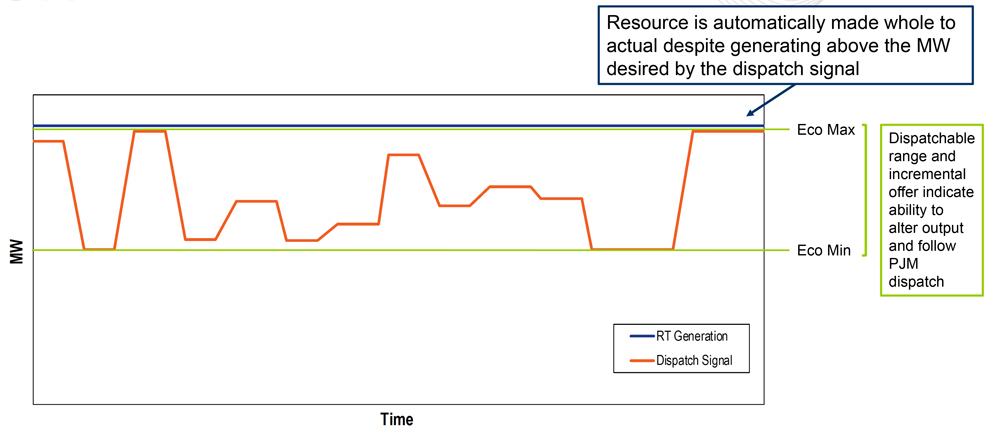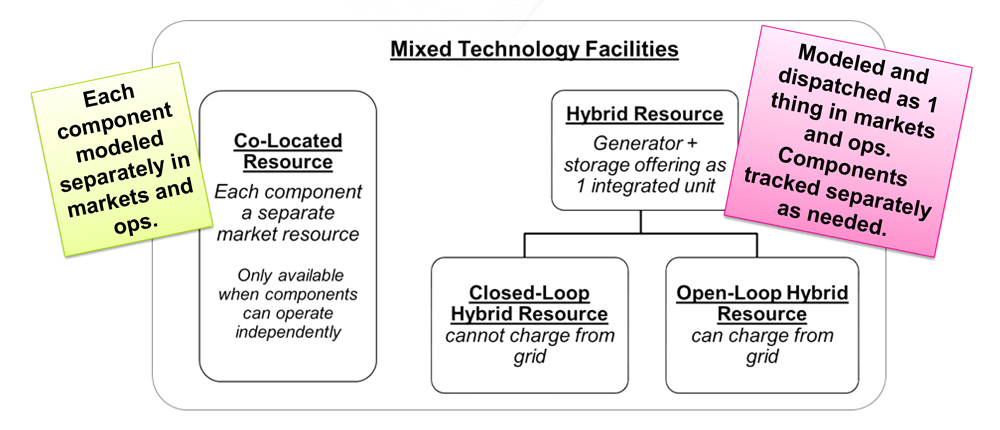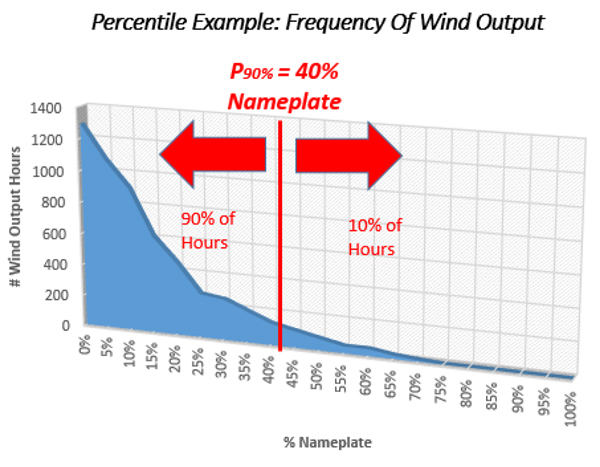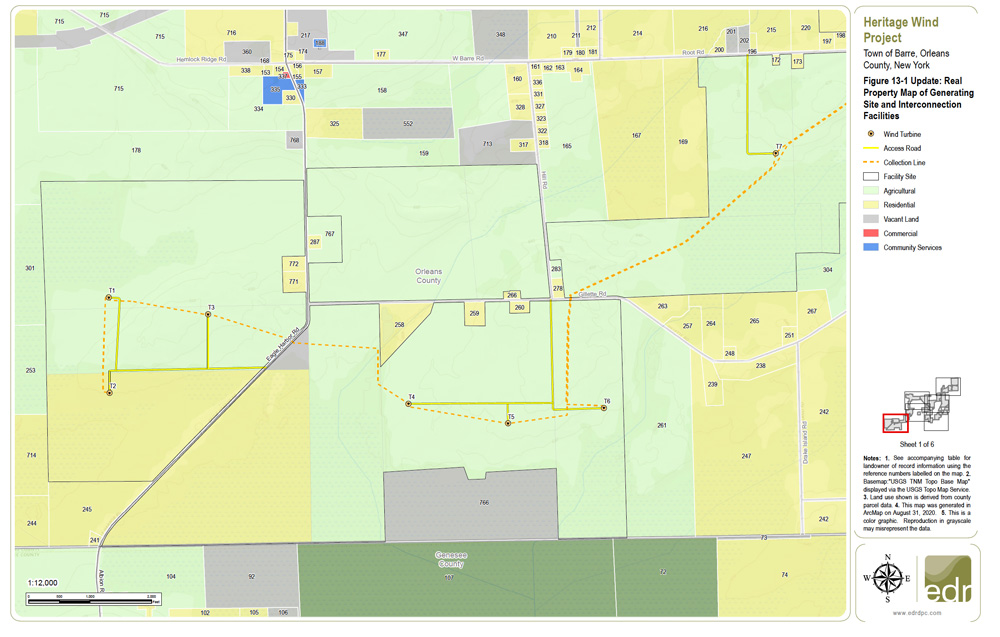Rule on Variable Environmental Costs and Credits Advances
VALLEY FORGE , Pa. — The PJM Market Implementation Committee last week approved a joint RTO-Independent Market Monitor proposal to update rules governing variable environmental charges and credits and their inclusion in cost-based energy offers.
Under the proposal, generation units receiving the production tax credit (PTC) or renewable energy credits (RECs) would have to reflect them in their fuel-cost policies (FCP) when submitting non-zero cost-based offers in the energy market.
The package includes changes to Manual 15 and Schedule 2 of the Operating Agreement. Under the changes, the review of emissions rates would be reduced from annual to every three years to align with the FCP review process. Emissions rates should not change drastically year to year, said PJM’s Melissa Pilong. The market seller is responsible for updating rates to ensure their accuracy.
The new rules would also add transparency on the information required from market sellers.
The IMM’s Joel Luna told the committee that RECs and PTCs must be included in cost-based offers under the same standards as fuel costs, and must be “accurate, verifiable and systematic.”
“In plain terms, it cannot be made up,” Luna said.
RECs can be based on the actual transaction price (inventory cost or contract-based) or spot price (replacement cost). If the actual price is used, the FCP must say how often the price will be updated and the period for the price (e.g., last year). If a spot price is chosen, the FCP must identify the source (e.g., broker/publication), data point used (e.g., midpoint/settled) and update frequency (e.g., weekly).
Units with bundled power purchase agreements making non-zero cost offers can use the actual REC price or spot REC price.
PTC rates are defined by the Internal Revenue Service and grossed up based on the effective corporate tax rate. For a company with a 21% tax rate, the $27/MWh PTC converts to $34.18/MWh ($27/(1-0.21)).
Jeff Whitehead of GT Power Group questioned why the RTO is including out-of-market revenue, saying it’s at odds with the effective elimination of the minimum offer price rule.
“We have a couple of ‘no’ votes [because of] the policy implications,” he said. “We’re wondering if we’re going the wrong direction with this policy.”
“Having the net cost reflects the true marginal cost of the units,” said Luna. Without such considerations, “you’ll be sending [solar and wind generators] a signal to curtail, and they will not respond.”
The proposal passed 180-39 (82%) with five abstentions. Stakeholders said they preferred the new rule over the status quo by 178-32, with 21 abstentions. It will receive a first read at this week’s Markets and Reliability Committee meeting.
Market Suspension Rules OK’d
Members also approved a revised PJM/IMM package of changes to the treatment of long-term market suspensions.
The changes are intended to address a gap in tariff language regarding how to settle the real-time market if prices can’t be determined. They would set separate rules for suspensions of less than and more than 24 hours.
Under a compromise, the intermediate suspension category was eliminated, and the “short term” suspension was expanded to 24 hours from six.
The changes apply to the real-time market when dispatch is unable to provide zonal economic dispatch results for at least seven five-minute intervals within a market hour. For suspensions up to 24 hours, PJM would substitute the missing prices with the average real-time price of those from the preceding and subsequent hours.
Suspensions longer than 24 hours would use day-ahead prices, if available. If not available, energy LMPs would be priced hourly based on an aggregate supply curve from available offers (including available resources not running), with actual generation megawatts serving as the proxy for demand. Loss LMPs and congestion LMPs would be set to $0.
The change included a friendly amendment by Shell Energy’s Sean Chang that stated if the suspension is greater than six hours but less than 24 hours, PJM would use day-ahead prices for corresponding hours.
 Tim Horger, PJM | © RTO Insider LLC
Tim Horger, PJM | © RTO Insider LLC
The changes do not affect suspensions of the day-ahead market, which will continue to use real-time prices as defined in tariff section 1.10.8(d).
Tom Hyzinsky of GT Power Group expressed concern with the changes, saying “day-ahead and real-time can be two completely different markets.”
PJM’s Tim Horger said 90 to 95% of load clears in the day-ahead market. “That’s why I feel confident using it for six to 24 hours.”
The changes were approved by acclimation with no objections or abstentions.
Initiative Approved on Weather-sensitive Load Compliance Rules
Members approved an issue charge proposed by Sharon Midgley, of Exelon (NASDAQ:EXC) and subsidiary Baltimore Gas and Electric (BGE), to explore an alternative demand response/price-responsive demand (PRD) compliance construct for weather-sensitive load, such as residential demand impacted by summer air conditioning.
 Sharon Midgley, Exelon | © RTO Insider LLC
Sharon Midgley, Exelon | © RTO Insider LLC
Midgley said the current rules compare metered load under prevailing weather conditions to the peak load contribution (PLC) based on weather-normalized peak weather conditions. Capacity compliance for DR and PRD is currently based on the firm service level (FSL), calculated as the PLC minus the amount of installed capacity that the DR/PRD resource cleared in the capacity auction. Compliance is achieved if metered load is at or below the FSL.
Over the summers of 2018-2021, the actual peak load for BGE’s weather-sensitive residential customers averaged 13% higher than the weather-normalized peak load. The disparity was the largest in 2019, with weather-normalized load 22% lower than actual load.
The discrepancy means DR and PRD providers may not be able to offer the full capability of their programs into the capacity market because of unachievable FSL, Midgley said.
Midgley revised the issue charge to make out-of-scope changes to the current compliance construct’s ruleset, which caps monetization to the customer’s PLC.
Monitor Joe Bowring opposed addressing the issue separately from ongoing discussions at the Resource Adequacy Senior Task Force. “We don’t think this is a narrow issue, and we don’t think it should be carved out from the RASTF,” he said.
Midgley said the RASTF’s work plan didn’t envision “getting to that level of detail.”
“I don’t see this as asking for special treatment,” she added.
The issue charge was approved with one objection for 22 members.
First Read on Day-ahead Zonal Load Bus Distribution Factors
PJM’s Amanda Martin gave a first read of a problem statement and issue charge addressing day-ahead zonal load bus distribution factors.
 This example shows the July 14 DA nodal load (left scale) is consistently 13% of the zonal load (right scale), while the July 7 RT load is only 6% of the zonal load. | PJM
This example shows the July 14 DA nodal load (left scale) is consistently 13% of the zonal load (right scale), while the July 7 RT load is only 6% of the zonal load. | PJM
The RTO’s current rules state that the default distribution of load buses for a zone in the day-ahead energy market is the state estimator distribution of load for that zone at 8 a.m. one week prior to the operating day. That means the share of the zonal load attributed to each node remains constant for all 24 hours, even though the node’s share of total load may vary throughout the day because of nonconforming loads, such as behind-the-meter solar and data centers. This can cause a mismatch between the day-ahead nodal loads and real-time state-estimated load.
“This seems overly simplistic given the data we have,” said consultant Roy Shanker. “I’m surprised we’re doing it this way.”
The committee will be asked to approve the issue charge at its next meeting under the “CBIR Lite” (Consensus Based Issue Resolution) process. The work is expected to take four months, with changes to tariff section 31.7c(i) and updates to Manual 11 and Manual 28.
IMM Balks at New Capacity Options for Generation with Co-located Load
Bowring expressed concern over proposals to change how PJM treats capacity offers from generation with co-located load.
According to the problem statement proposed by Brookfield Renewable Trading and Marketing and Constellation Energy — and approved by stakeholders in January — PJM’s current rules do not allow capacity offers for the full output of generating units that are contracted to physically serve co-located loads, instead requiring owners to retire a portion of their capacity to serve such loads.
The companies said large commercial customers with fast-response curtailment capability (less than 10 minutes) are seeking physical supply options for loads that are directly interconnected behind carbon-free generation resources such as hydro and nuclear.
Changing the rules would provide customers more options and give PJM the ability to call on the generators serving such interruptible customers, backers say. The initiative could result in modifications to capacity market rules, cost-based offer rules and relevant manual provisions to account for co-located load configurations.
“We have lots of large loads that can drop at any time on the system,” said Shanker. “Operationally, I don’t think this is anything new.” He added, however, that the magnitude could be increasing.
But Bowring said the proposal is a “significant change” that removes, rather than adds, flexibility. He said it could mean that a large nuclear power plant will no longer provide its energy to PJM in most hours but will be paid as if it is a capacity resource.
Discussing the impact of an unexpected drop in the behind-the-generator load, he said, “It’s not just a load drop. It’s a sudden increase in generation. … Everyone needs more details about this to be convinced it’s business as usual.”
He also said the impact of the proposed change on the provision of reactive power and frequency control by the generator must be explicitly defined.
 Jason Barker, Constellation Energy | © RTO Insider LLC
Jason Barker, Constellation Energy | © RTO Insider LLC
Constellation Energy’s Jason Barker asked Bowring to be specific about the analysis he seeks, saying he wanted to avoid his request from “unduly delay[ing] consideration of this process.”
“The process has worked in the past to adjust interconnection service agreements,” Barker said.
PJM’s Jeff Bastian said the RTO currently operates the system prepared for the loss of its largest units. “If you lose a 300-MW load behind the meter of a generator, the system is going to react the same as if you lose a 300-MW paper mill or any other kind of load that’s connected to the system. So I’m not sure I understand the concern,” he said.
PJM’s Lisa Morelli said she will continue discussions outside of the MIC “to make sure we’re not talking past each other.”
CT Make-whole Loophole Discussed
Members discussed a proposal to close a loophole that allows combustion turbines to ignore PJM dispatch without financial consequences.
Under PJM rules, most resources are made whole to the lesser of their actual megawatt output or the RTO’s desired output. But CTs are always made whole to their actual megawatts, regardless of how well they follow dispatch, Morelli explained.
 The distance between the orange (dispatch) line and blue (actual operation) line represents excess MWs for which the combustion turbine can receive make-whole payments under current PJM rules. | PJM
The distance between the orange (dispatch) line and blue (actual operation) line represents excess MWs for which the combustion turbine can receive make-whole payments under current PJM rules. | PJM
PJM and the Monitor said the special treatment made sense before the implementation of Capacity Performance, when CTs were not required to have a dispatchable range. Most CTs now share similar dispatchability to the rest of the fleet, they said.
Flexible CTs received 72% of all balancing operating reserve credits in 2021, “so changes to this rule can be quite meaningful,” said Morelli.
PJM reran the highest uplift days for CTs from summer 2021 and found that with the CT exception eliminated, uplift payments to CTs would drop from $13.4 million to $12.2 million over the eight days — a reduction of $1.3 million (10%).
“$1.3 million for eight days is pretty significant, so that would grow over a whole year,” Morelli said. “I think it does make a strong case for removing the CT rule.”
She called the change “low-hanging fruit,” although she acknowledged, “we realize some CTs are not flexible.”
Timing of ARR/FTR Market Task Force Talks at Issue
PJM backed off from a recommendation to delay additional work on new seasonal auction revenue rights (ARRs) and financial transmission rights (FTR) products in the face of opposition by DC Energy.
In a poll of 129 members of the ARR/FTR Market Task Force, 98% answered “yes” to the question: “Should the annual ARR/FTR products be retained and seasonal products be added (recognizing that fewer rounds would be required)?”
Almost two-thirds (64%) of those polled also supported “pursuing any other ARR/FTR market reforms at this time.”
 Dave Anders, PJM | © RTO Insider LLC
Dave Anders, PJM | © RTO Insider LLC
A much smaller majority (57%) supported retention of the annual ARR/FTR products. “So no real conclusory evidence there on where people want us to go,” said task force facilitator Dave Anders.
Asked what process changes the task force should pursue to simplify auctions to allow additional products, 60% favored adjusting the structure of the annual auction (e.g., number of rounds), and 83% supported modifications to overlapping periods and/or class types.
In contrast, “adjustments to the annual ARR allocation process” drew only 26% support.
After reviewing the poll results, Anders recommended that the task force delay discussions on new products until late 2023 or early 2024 to allow the September 2022 Phase I (new FTR product type) and February 2023 Phase II (ARR changes) be implemented first. Those changes were approved by FERC on March 11 (ER22-797).
“Let’s make sure we’ve got some stability before we make additional changes,” he said.
Anders also proposed revising the task force’s issue charge to “narrow the focus down to, what do we want to accomplish going forward?”
“The issue charge was exceptionally wide open,” said Anders. “Being able to say the task force is done is an important thing.”
“Where did this recommendation come from?” asked Bruce Bleiweis of DC Energy. “It wasn’t discussed.”
“As facilitator of the task force, this is my recommendation,” responded Anders.
Bleiweis said he agreed with revising the charter, but he said he would oppose waiting “another year and a half to begin those discussions.”
“I don’t think we need to wait for the implementation of the new products and class types, because they’re different from what we’re recommending” he said.
“This is just my recommendation,” Anders responded. “We’ll go whatever direction the stakeholders want to go.”
Anders said he would return to the group with “a more definitive path forward.”
Separately, the MIC endorsed changes to Manual 6: Financial Transmission Rights as part of the periodic review and to make changes conforming with FERC’s March order. The changes include definitions of new FTR class types and clarification of the remaining time frame for existing off-peak classes. Also added was a new rule on the minimum price for clearing options. The first of the changes will be effective Sept. 1 and be applied first to the October 2022 auction, which opens in mid-September.
Wolf’s Appeal Reinstates RGGI Costs in Pa. — for Now
On July 11, Pennsylvania Gov. Tom Wolf’s administration appealed the Commonwealth Court’s injunction blocking the state from entering the Regional Greenhouse Gas Initiative (RGGI), effectively lifting the injunction. (See Court Blocks Pa. from Joining RGGI.)
“As a result, generators can include RGGI costs in their cost‐based offers per their approved fuel-cost policies beginning on July 13 for July 14, unless and until the injunction is reinstated, if it is,” the Monitor advised in a notice.
Manual Revisions Approved
Members also endorsed revisions to:
- Manual 18: PJM Capacity Market to conform with FERC’s July 12 order regarding hybrid resources (ER22-1420). A hybrid is defined as a single generator plus a single storage facility operating as a composite. The change adds hybrid resources to the exemption from the capacity market must-offer rule currently applied to intermittent resources and capacity storage resources.
- Manual 28: Operating Agreement Accounting to support the start-up cost offer development proposal the MRC approved in May. It clarifies what intervals are included in segments for determination of balancing operating reserve credits.


